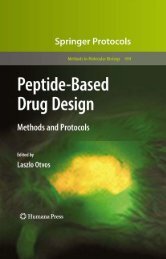You also want an ePaper? Increase the reach of your titles
YUMPU automatically turns print PDFs into web optimized ePapers that Google loves.
178 Jenssen and Aspmo<br />
Some other peptides, e.g., dipeptidyl peptidase IV (8), endopeptidase 3.4.24.16<br />
inhibitor (9), and a copolymer of tyrosine, glutamic acid, alanine, and lysine<br />
(10), have also demonstrated immunomodulatory activity. Thus analogues of<br />
these may some day play an important role in treatment of autoimmune and<br />
inflammatory diseases. It should also be noted that a vast number of naturally<br />
derived peptides also has demonstrated antimicrobial activity toward a wide<br />
range of pathogens (11), resulting in possible templates for further optimization<br />
studies clearly demonstrating the potential importance of peptides as pharmacological<br />
tools.<br />
However, the majority of positive leads identified so far have been isolated<br />
from the natural reservoir of peptides. A possible explanation for this may be that<br />
these peptides have undergone natural selection over billions of years, resulting<br />
in enhanced in vivo stability. Another explanation may be that the majority<br />
of random peptide sequences from chemical and recombinant libraries do not<br />
fold into stable structures (12); however, this may not nessesarily render these<br />
peptides more susceptible to proteolytic degradation.<br />
<strong>Peptide</strong>s have several advantages over small molecular drugs, e.g., they have<br />
higher affinity and specificity to interact with its target, while their toxicity<br />
profile remains low. However, several issues have prevented small proteins and<br />
peptides from becoming a mainstream template in drug design. This is primarily<br />
due to rapid renal clearance and low in vivo stability as a result of protease degradation,<br />
giving them a rather short half-life. Bioavailability and limited access<br />
to intracellular space has also been debated. However, peptide-based antimicrobials<br />
are with no doubt suitable for topical applications (13), offering decreased<br />
potential of resistance induction (14) compared to other antimicrobials.<br />
Synthetic peptides often lack the conformational stability required for a<br />
successful drug; therefore determination of peptide stability in serum constitutes<br />
a powerful and important screening assay for the elimination of unstable<br />
peptides in the pipeline of drug development (see Note 1). <strong>Peptide</strong> stability in<br />
serum can rather easily be determined by reverse phase–high-performance liquid<br />
chromatography (RP-HPLC) and mass spectroscopy (MS) from both in vitro<br />
and in vivo studies.<br />
2. Materials<br />
2.1. Solid Phase <strong>Peptide</strong> Synthesis and Purification<br />
1. PAL-PEG resin, Fmoc amino acids and coupling reagent N,N´diisopropylethylamine<br />
(DIPEA) and O-benzotriazole-N,N,N´,N´-tetramethyluronium-hexafluoro-phosphate<br />
KY).<br />
(HBTU) (Advanced ChemTech, Louisville,






